What Will You Learn?
In this course, you will:
Explore image classification, segmentation, object localization, and detection.
Apply transfer learning to object localization and detection.
Implement object detection models like regional-CNN and ResNet-50.
Customize existing models and build your own for detecting, localizing, and labeling images, including personalized rubber duck images.
Implement image segmentation using variations of fully convolutional networks (FCN), including U-Net and Mask-RCNN.
Identify and detect objects such as numbers, pets, and zombies through image segmentation.
Utilize class activation maps and saliency maps to interpret and improve the design of networks, with a focus on the famous AlexNet.
Inspect and enhance model predictions by understanding which parts of an image are used by the model in making predictions.
Apply machine learning interpretation methods to refine network design and improve performance.
About This Course
Provider: Coursera
Format: Online
Duration: 19 hours to complete [Approx]
Target Audience: Intermediate
Learning Objectives: Upon completion, you will master image classification, segmentation, object localization, and detection, applying transfer learning, customizing models, and building your own for tasks like rubber duck detection and image segmentation with FCN variants.
Course Prerequisites: Basic calculus, linear algebra, stats, Knowledge of AI, deep learning, Experience with Python, TF/Keras/PyTorch framework, decorator, context manager
Assessment and Certification: Earn a Certificate upon completion from the relevant Provider
Instructor: DeepLearning.AI
Key Topics: TensorFlow Object Detection API, Class Activation Maps, Model Interpretability, Image Segmentation, Salience, Computer Vision
Topic Covered:
- - Classification and Object Detection Intro
- - Segmentation Intro
- - Why Transfer Learning?
- - What is Transfer Learning?
- - Options in Transfer Learning
- - Transfer Learning with ResNet50
- - ResNet50 in code
- - Network architecture for Object Localization
- - Evaluating Object Localization
- - Object Detection and Sliding Windows
- - R-CNN
- - Fast R-CNN
- - Faster R-CNN
- - Getting the Model from TensorFlow Hub
- - Running the Model on an Image
- - Installation and overview of APIs
- - Visualization with APIs
- - Loading a RetinaNet Model
- - Loading Weights
- - Data Prep and Training Overview
- - Custom Training Loop Code
- - Image Segmentation Overview
- - Popular Image Segmentation Architectures
- - FCN Architecture Details
- - Upsampling Methods
- - Encoder in Code
- - Decoder in Code
- - Evaluation with IoU and Dice Score
- - U-Net Overview
- - U-Net Code: Encoder
- - U-Net Code: Decoder
- - Instance Segmentation
- - Why Interpretation Matters?
- - Class Activation Maps
- - Fashion MNIST Class Activation Map code walkthrough
- - Saliency
- - GradCAM
- - ZFNet

0 Comments